NRL and CTE: Mark ‘Spudd’ Carroll reveals probable chronic traumatic encephalopathy (CTE) diagnosis
Rugby league hard man Mark ‘Spudd’ Carroll opens up for the first time on his CTE diagnosis, revealing before he was diagnosed he ‘dreamt’ of driving his car into a tree or an oncoming semi-trailer.

Mark Carroll, one of the toughest men to have played rugby league, was about to open his gym for the day when he took a phone call from his neurologist that left him in floods of tears and panic.
Late last year Rowena Mobbs called “Spudd” and told him he had been diagnosed with probable chronic traumatic encephalopathy (CTE), a brain disease linked to repetitive head knocks.
“Am I going to die?” Carroll asked Dr Mobbs as tears rolled down his face.
Carroll knew Sharks halfback Paul Green, who was unknowingly suffering CTE, had recently taken his own life. “Doc, you are scaring me,” Carroll then said.
In that moment Carroll begged the neurologist to call his wife Monique and to “please explain in plain English” what was happening to him and his brain. Dr Mobbs told him – and later told his wife – that a PET scan of Carroll’s brain had revealed damage and neuropsychological tests indicated a cognitive decline.
In his first interview since his CTE diagnosis, Carroll, the former Kangaroos and State of Origin footballer breaks down in tears several times as he opens up to The Weekend Australian about his painful mental spiral over the two years leading up to his diagnosis. The 56-year-old says that before his CTE diagnosis, such was his anguish, he “dreamt” of driving his car into a tree or an oncoming semi-trailer on a Sydney main road. “My brain was ticking like a bomb,” Carroll says. “Every morning driving to work early at 5.05am, why I know that number, that is the time I remember when I’d look at my clock going around a bend on Mona Vale Rd in complete darkness, because there are no lights in that section, where I hate to say it, I was hoping a massive semi-trailer was coming the other way. Thank God it was always a car.
“I also dreamt about driving into a big f..k-off tree near my house. But also in my head I am saying; ‘don’t do it, don’t do it’.”
Carroll stops himself and says he feels sick thinking back to that dark time. “The reality is blokes (who have CTE) are taking their own lives,” he says. “I am telling the story of my CTE diagnosis, not for sympathy, not for myself, but for the other former footballers, who I know are suffering in silence. I want them to get help.”

Carroll enjoyed a 200-plus game career defined by brutal clashes with Knights enforcer Paul “The Chief” Harragon, a premiership victory with Manly, playing Origin and for the Kangaroos – but all that footy glory has come at a cost.
Carroll, who had more than 50 concussions in first grade, is speaking out because he says the “silent suffering has to stop” and brain scans should be provided to all former footballers by the NRL. He implores NRL bosses Peter V’landys and Andrew Abdo to make this happen. “I do believe there should be more care for ex-footballers of all eras,” he says. “I think the NRL – who made a $63m profit last year – should be providing MRI/PET scans.
“To the men who played in my era and the eras before – the men who were my heroes and I wanted to be like: please get a brain scan.”
While 60 former players lodged legal action against the AFL on Tuesday over head injuries, a day before the NRL announced a mandatory 11-day concussion stand-down rule the next day, Carroll has no interest in compensation. “This is not a story about money or compensation,” he says. “I have no interest in a lawsuit – which is happening in the AFL now. I am just a man talking in a hope to help other blokes who might be battling. I want them to alert them to the signs.”
Carroll remains under the care of Dr Mobbs, a neurologist at Macquarie University and director of the Australian CTE Biobank. She is ensuring he is part of Concussion Connect, a group of former footballers and people with brain injuries who meet for support. “CTE can affect players from their 30s, and is an insidious form of dementia over many years,” she says. “That Mark has some insight and awareness of his predicament is a testament to his intelligence and resilience.”
Warning signs
It had been two very troubling years for Carroll before he was diagnosed late last year. Over this time his wife Monique and his children Indianna and Joshua, now in their 20s, had noticed changes in their father’s behaviour. Some changes were subtle; others were more obvious.
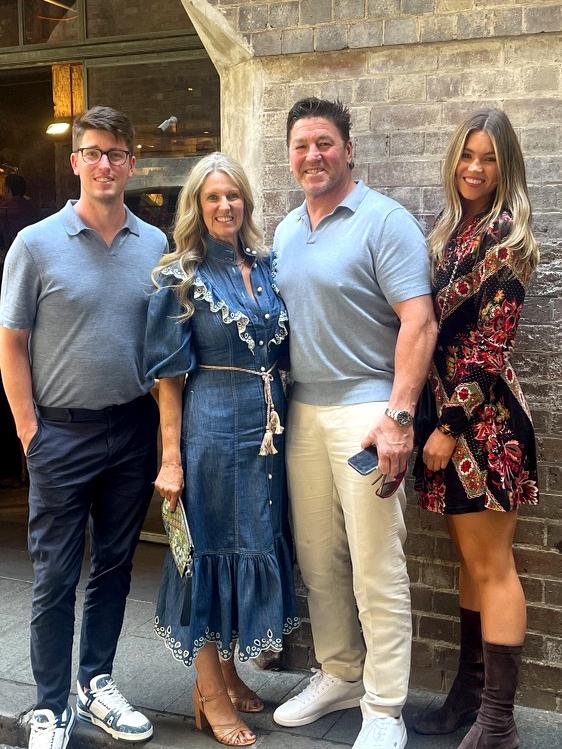
Carroll says he really started mentally capitulating during the second extended Covid-19 lockdown in Sydney in 2021. With his Darlinghurst gym again not open, he had lost his routine and community of dedicated trainers. With all this spare time he was having paralysing anxiety attacks and depressive episode. Even as lockdowns lifted, he was struggling.
“My life derailed,” Carroll says.
Those were the mornings he drove to work and “dreamt” of crashing his car. He would often wake paralysed by “worry” at 4.30am. Worrying about his gym and how he was going to provide for his family if he couldn’t open it. Worrying about his worrying thoughts, which were getting very sinister. He would lie in bed frozen by bad thoughts, wanting to move but unable to.
“I was worried about my thoughts about running my car into the tree,” he says. “I’ve always been a worrier. Always. But these worrying thoughts meant most mornings during this time I could not get out of the bed. I felt like shit. It was like I was concreted to the ground.”
Around this dark time at the end of 2021 he was at a loss as to why he was feeling so bleak. He saw a psychiatrist who flipped between diagnosing him with bipolar and ADHD.
Finally, with Monique’s prodding, he went to his GP who diagnosed him with depression. He was prescribed depression tablets. Then Carroll insisted on changing the brand because to him they weren’t working. “I am the most impatient person in the world, and after four days, I said they weren’t working, I tried another brand … I tried four different types of antidepressants in four weeks, waiting for the magic to begin, but I feel like this all might have poked the bear,” he says.
He lived in this cycle fighting with the “squirrels in my head”, fighting the darkness, and feeling like he was losing it mentally.
Then there were the rages. The hot temper has always been there. He’s the kind of guy who after learning he had not been selected for the 1994 Australian Kangaroos team spewed anger. “I destroyed every single piece of furniture in our house,” Carroll says. “Throwing it into the walls. Crying out of control. Looking back now, the sound of Monique screaming ‘stop it stop it’ still rings in my ears. The negativity of not making the team destroyed me.”
While he has always aimed his anger at inanimate objects (off the field at least), people have come into this physical firing line of late, including an interaction with a client in his gym, who was “verbally niggling him”. Carroll lost it and pinned the man by the throat. “I had him up against the wall,” he says. “Thankfully there were other people there that separated us.”
Carroll apologised. He knew he needed help. Then he was introduced to Dr Mobbs.
Podcast awakening
What had pushed Carroll to the neurologist was listening to The Australian’s podcast investigation Head Noise, hosted by NRL great James Graham, which explored the impact the game had on his brain and the damage done.
“In every episode, I was ticking the box of the symptoms, and saying: ‘this is me, this is me, this is me’,” Carroll says. “I contacted James to say ‘I need to speak to Dr Rowena Mobbs’ and ‘I want to do a podcast with him’.”
On Head Noise Graham and other former footballers had spoken of paralysing anxiety and an unshakeable depression – some spoke of suicidal thoughts. Around this time, there was also the sudden death of former halfback and premiership-winning Cowboys coach Paul Green. A post-mortem found he had stage-three CTE. “In some capacity I felt some guilt about Paul’s passing, because I had delivered punishment against him,” Carroll says. “I am sorry.”
And he couldn’t ignore fellow Souths hardman Mario Fenech’s recent probable CTE diagnosis. Fenech now has dementia.
“I feel for Mario,” Carroll says. “He was a bloody tough hombre. But the game we played back then, you had to get in first before you got whacked. “Mario was one of the easiest to clean up on the field, and one of the easiest to make snore. One of Mario’s signature moves was to fly out of the line, when playing for North Sydney. He was a left-arm hitter and he would be aiming for your chin. In return, I had to get in first. My signature move was the shoulder charge, aiming for the chin, and the strike rate was high.”
Monique says her husband is now paying a price but she is proud of “Spuddy’s” move to go public with his battles.
“I do think that he is being brave by letting his guard down and telling his story,” Monique says. “He was one of the game’s hardest hitters and now he is showing his vulnerable side. He is being very courageous by speaking about what he is going through. Now he’s suffering.”
Lifelong influences
Carroll’s life has run on a mantra of “don’t let fear hold you back”. It’s written in black letters on his gym entry. A humble sweatbox of a gym in Sydney’s Darlinghurst packed with equipment where everyone from Hollywood actors, Waratahs forwards, rugby league hard men, media executives, stars and the ordinary man train.
“There’s no PC and you’re going to cop it,” Carroll says.
“People come for the Carroll experience. My clients try to physically and mentally break me but they will never win.”
Carroll prides himself on his ability to withstand physical pain.
He was heavily influenced by his father Dave’s approach to pain. A man who suffered 70 per cent burns to his body at the age of 21, he continuously told his son that the pain he experienced was “nothing you could ever imagine”.
Before every game Dave would ring Carroll and give him a brief list of footballers to hurt. “Dad never played footy, he was a muso, but he knew everything in my mind,” he says. “When he would ring, it was short, he’d give me two people to bash and then say get the first shot in and then hang up. That was for my whole career.”
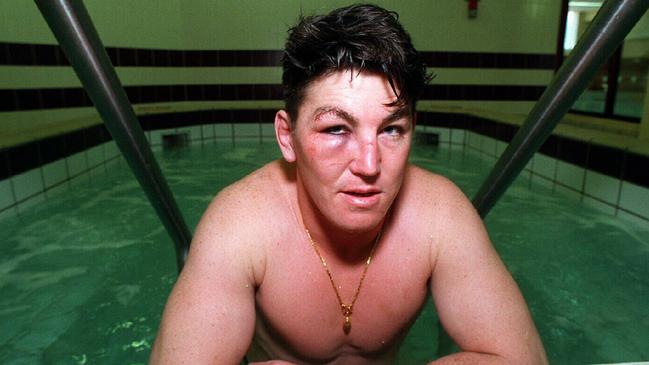
The other piece of advice from his dad was also simple. “He said: ‘Never show you’re hurt and always get up’,” Carroll says. “When I look at past vision of myself stumbling around and finally getting into the defensive line, people have often asked how the f. k did I get up from the ground, I would say: ‘If I didn’t get up I was more worried about my dad jumping the fence and kicking me up the arse’.”
When he was knocked out for the first time at 14, a blow that left him vomiting at night, the next day he was back training again. His Manly and Kangaroos coach Bob Fulton would call him “soft” if he ever came off the field injured. He had 188 stitches above his right eye from one season of football in 1995. “I had a staple gun to the head, with no anaesthetic; yeah that hurt, but still it was nothing in comparison to what my dad went through,” Carroll says.
He says he would do whatever it took to help his team win – and to please his dad and “Bozo” Fulton, his Kangaroos coach. On the Kangaroos tour in 1995, when the “blood bin” was a good rort to rest players and then return them to the firing line, Carroll happily obliged by gashing open an old wound above his right eye with a scalpel before the game, which he would keep bandaged until he needed to come off.

“I was so desperate to win a World Cup at Wembley, after getting shafted from the Kangaroos team in 1994, I just knew I had to take one for the team,” he says.
“I remember going to the doctor and asking him to just cut the stitches open with a blade and he said: ‘You’ve gotta be bloody kidding me I’m not doing it’. So I grabbed the scalpel and I said to our trainer, ‘come with me’. Without any hesitation I nicked open the 18 stitches, naturally blood came pouring out, we taped it up.
“With this blood bin opportunity, my role was to go out there for the first 20 minutes and go ballistic, then come off. The trainer would run on and take the tape off. But in that short time it had congealed together. So the trainer just pushed it with two fingers into my wound to make it bleed again. It spurted blood everywhere. I did that multiple times in the game. My eye was a mess. But, hey, we won the World Cup. Things you do for people at any cost.”
The whole right side of Carroll’s body bears the markings of the way he played. He has broken every finger in his right hand. His right ankle has been fused. He needs a new right knee. He right ear is “cauliflowered”. He had plastic surgery to repair above his right eye (the 188 stitches). But it’s the right side of his brain that is showing the most damage.
As he battles CTE he is being wholly supported by his family. Hollywood star Russell Crowe, who inspired him to open his gym SPUDDS 17 years ago, has recently checked in on him. Carroll says his employer, Fox Sports, has been amazing. His boss Steve Crawley was one of the first people he told about his diagnosis. “I really appreciate the support and love he has showed me,” he says.
Some of the anxiety Carroll suffers has been tempered by recently securing year-long contracts with Fox Sports and SEN Radio. “It makes me feel more positive, knowing I am wanted, and that I have something to look forward to,” Carroll says. “To both parties, I said to them ‘never, ever, will this disease have a negative effect on my performances’.”
But daily life remains, at times, a battle.
“Some mornings are torture, Sundays being the worst,” he says.
It is Sundays when his gym is not open, those days he has to use all his might to beat away the anxiety, the worry. Some days he struggles to open his eyes.
When he finally does get himself out of bed, he hits the jet ski and rips up Pittwater to give his brain a break and lift his mood.

Getting to sleep is also problematic. Because of his swirling thoughts he takes a cocktail of relaxants and sleeping pills.
“Over the last two years I have taken meds like Valium, sleeping tablets, melatonin every night – they’re the only things that shut me down,” Carroll says. “So I can at least have five hours sleep otherwise I can’t turn my brain off. Squirrels start working in this massive melon (his head).”
There are still pills for depression and pills for his CTE symptoms. “I feel like I rattle when I walk,” he says.
But for the kid who grew up wanting to be on a Scanlan’s footy card, he made that dream happen – but the game he loves has cost him and his family.
Regrets? “No, I have no regrets. I would play tomorrow,” he says.
As the interview winds to a close, Carroll is in tears again. He says to all the ex-players out there, who might be suffering: “Please find my number, ring me anytime and I will try and steer you in the right direction for help. I am so happy now that I can help other players. I am hoping these words, my words, will change someone’s life for the better. I hope this makes any player who has played this bloody great game to please go and get your brain tested. I hope it comes back with a positive tick – that’s a pass – not a bloody cross like mine.”
If you or someone you know is at risk of suicide, call Lifeline (13 11 14) or the Suicide Call Back Service (1300 659 467), or see a doctor.
Macquarie University’s Concussion Connect email: neurology@mqhealth.org.au
-
Carroll showing ‘classic’ symptoms of brain disease
Dr Mobbs, who is treating Carroll, said the former footballer’s symptoms were “classic” for someone with the brain disease.
“Mark has the classic profile of someone with CTE, suffering a gradual decline in cognition, mood and behavioural regulation, backed up by characteristic abnormalities on neuropsychology testing and brain imaging,” Dr Mobbs said.
“CTE can affect players from their 30s, and is an insidious form of dementia over many years. That Mark has some insight and awareness of his predicament is a testament to his intelligence and resilience.”
A neurologist at Macquarie University and director of the Australian CTE Biobank, Dr Mobbs commended Carroll’s bravery in telling his story.
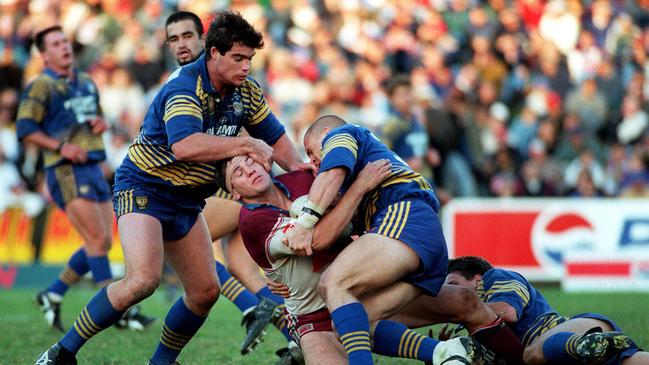
She has also overseen the care of former Souths star Mario Fenech, who has also been diagnosed with CTE, and James Graham, who last year revealed he had brain damage.
“Mark is committed to seeing positive change in rugby league to ensure that children entering this great sport are kept safe, and to encourage his fellow players to reach out for neurological care if concerned,” Dr Mobbs said.
“At Macquarie University, we have run the Concussion Connect program for the last three years, giving players and families strategies for improved quality of life during CTE, knowing that there is no cure.
“It’s heartbreaking to see our former sporting heroes floundering without support. We welcome the federal government’s initiative to form the Senate inquiry, and we trust that the football codes will work together with government on independent research to track affected players during life.”


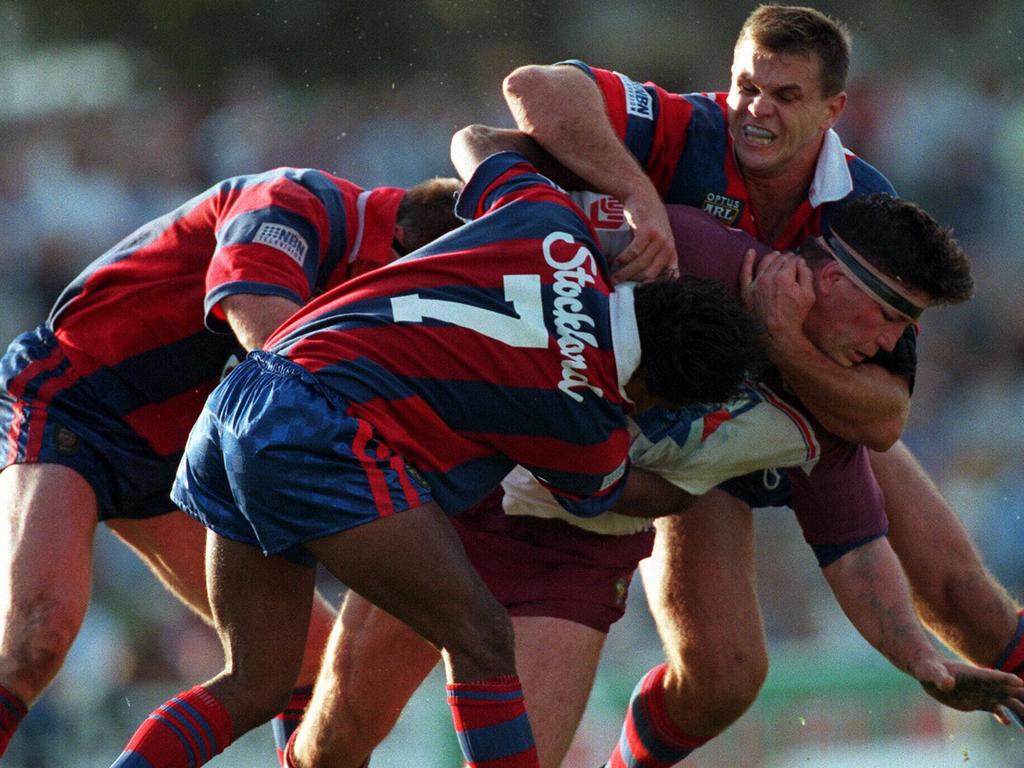


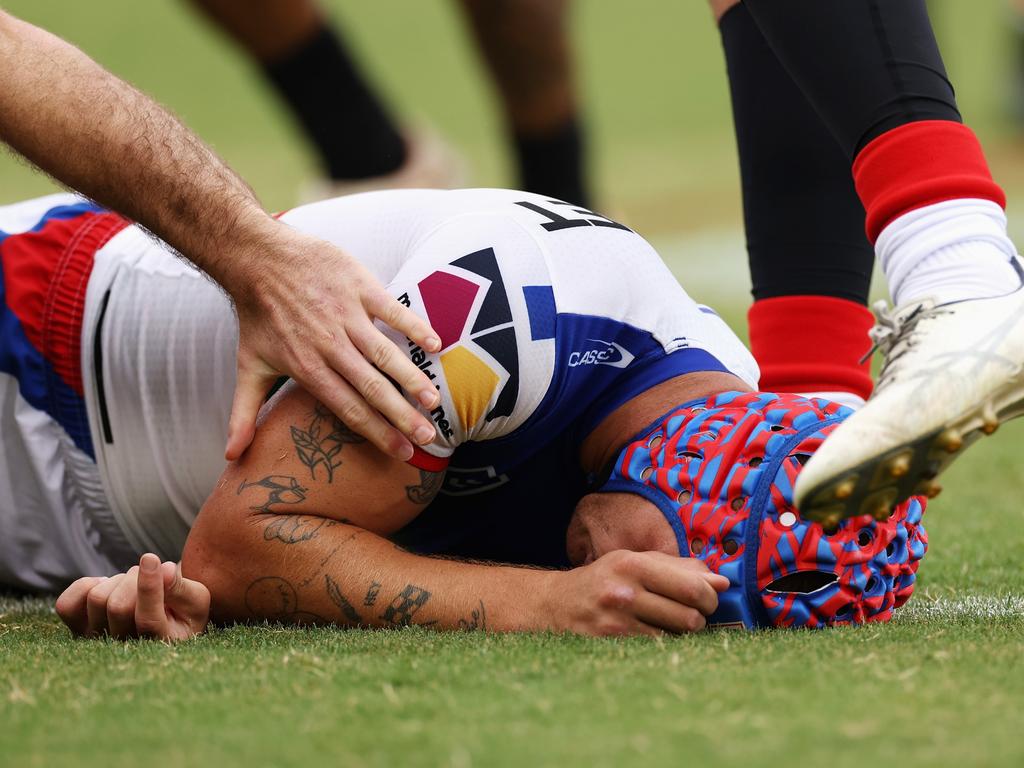
To join the conversation, please log in. Don't have an account? Register
Join the conversation, you are commenting as Logout